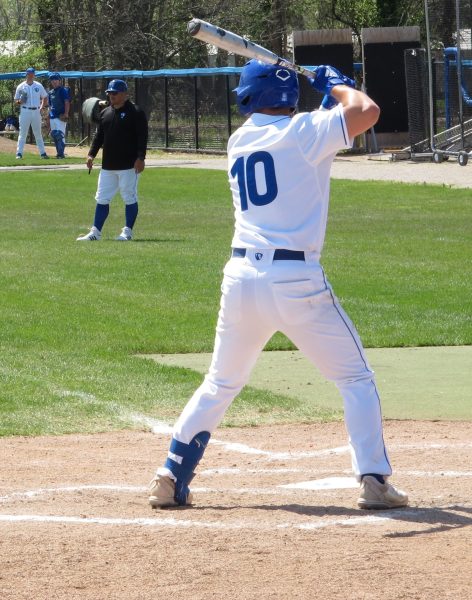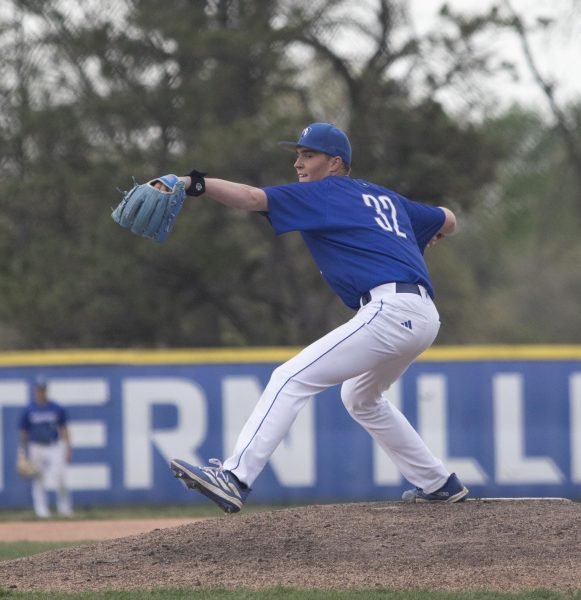Students pushed to limits in challenge
As a brisk and blustery wind swept over O’Brien Field Saturday, students tested their strength and endurance alongside Marines.
Students were participating in the second annual Marine Combat Fitness Challenge, hosted by the U.S. Marine Corps.
Capt. August Christhilf, a Marine Corps officer selection officer, said the challenge was a modified version of the Marine Corps Combat Fitness Test all Marines must complete annually to measure their fitness level.
The challenge, set up for students to take, was only a section of the actual Marine Corps Fitness Test and was not as challenging, he said.
“We are cutting it down a little because we don’t know the range of people showing up, and we want everybody to be able to participate,” he said.
The main purpose of the challenge is to test the different levels and types of fitness and endurance of students, Christhilf said.
“Some people are fit, like in the gym, but can’t run. Some people are runners, but they aren’t used to carrying any weight,” he said. “This is like a cross fitness type exercise where it is going to test you in all areas.”
With steady winds near 20 mph and temperatures barely touching 50 degrees, students signed in and prepared to take on the challenge.
Hillary Reynolds, a senior elementary education major, and Maggie Buoy, a senior psychology major, paired up for the challenge and said they were eager to compete for Alpha Gamma Delta sorority.
“We are up for the challenge,” Buoy said, wrapped tightly in a track jacket. “We’re ready to go.”
Both Reynolds and Buoy said they were not sure what to expect, but were ready to fight the cold, wind and whatever obstacles the challenge provided.
“We’re just diving in headfirst,” Buoy said.
Joe Hogan, a senior communication studies major, signed in to represent Sigma Pi fraternity, wearing a pair of basketball shorts and a long-sleeve shirt despite the frigid weather.
“I’m freezing. I didn’t think it was going to be this chilly,” he said. “The wind is killer.”
As he warmed up for the challenge, sprinting the length of the field several times, Hogan said he heard the challenge was harder than it seemed.
“I heard it’s actually pretty hard,” he said. “One of our best athletes in our house was puking his guts out last time.”
Along the end zone, Buoy laid on her stomach in wait for the signal from an attending Marine, who had a stopwatch in his hand.
At the go, she leapt to her feet and sprinted 25 yards to loop around a traffic cone.
Dropping to her hands and knees, she crawled 10 yards to another array of cones.
Zigzagging on foot through the cones, she ran to Reynolds, simulating a wounded soldier. Taking a hold of Reynolds from behind, Buoy dragged her 10 yards toward the starting line before throwing Reynolds over her shoulder in a fireman’s carry.
Reynolds teetering and fighting to stay balanced, Buoy hauled her to the starting line.
Once back in the end zone, Buoy picked up two 17.5 pounds rubber weights and ran them to the other end of the field.
Here, she had to throw a dummy grenade into a 2.5-square-yard box taped onto the field before running the weights back to the starting line.
Stumbling under the pressure of the weights and her own exhaustion, Buoy fell to her knees the last few yards before crossing the starting line with a time of 3:18.
Her face red from the cold wind and hard work, Buoy said the challenge was a true test of her strength, endurance and teamwork skills. She said the hardest part of the challenge was hauling Reynolds back to the starting line.
“I think dragging her was the hardest part,” Buoy said between short, deep breaths. “I did not have a good grip on Hillary at all.”
Crossing the starting line with a time of 2:59, Hogan laid flat on his back, his stomach heaving with each gasp of cold air.
“No doubt, it was a lot harder than I thought it was going to be,” he said. “It was awful, but I’m glad I woke up and decided to do it.”
The difficult challenge not only pushed Hogan to his physical limits, it also gave him an appreciation for how hard Marines must push themselves to stay fit for service.
“(Marines) are beasts, no doubt,” he said. “They’re animals.”
As other students struggled to cross back over the starting line, 2nd Lieutenant Nathan Bertrand said he hoped the challenge opened students’ eyes to the rigors of Marine life and reality of military service.
“Hopefully, it will give them a small appreciation for what the average Marine is expected to do on a daily basis,” he said. “This is about the closest they will ever get to it.”
Tim Deters can be reached at 581-2812 or [email protected].












































